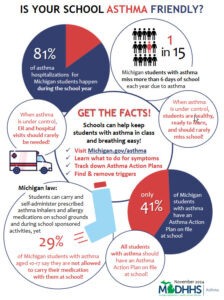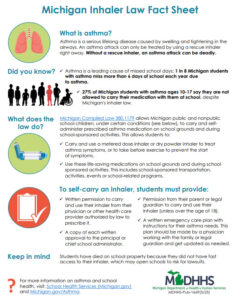Schools and Asthma
For every classroom in Michigan with 30 children in it, two may have asthma. This chronic disease causes unnecessary restriction of childhood activities, and is a leading cause of school absenteeism. Asthma can be controlled, though, and with proper treatment and support, children with asthma can lead fully active lives.
- School Asthma Data
- School – Asthma Policies and Law
- School Staff Resources
- Asthma in Schools – Tools and Resources
MI Inhaler Law Fact Sheet – Michigan law allows Michigan public and nonpublic school children, under certain conditions, to carry and self-administer prescribed asthma and allergy medications on school grounds and during school sponsored activities.
Is Your School Asthma Friendly Infographic
What To Do in an Asthma Emergency

